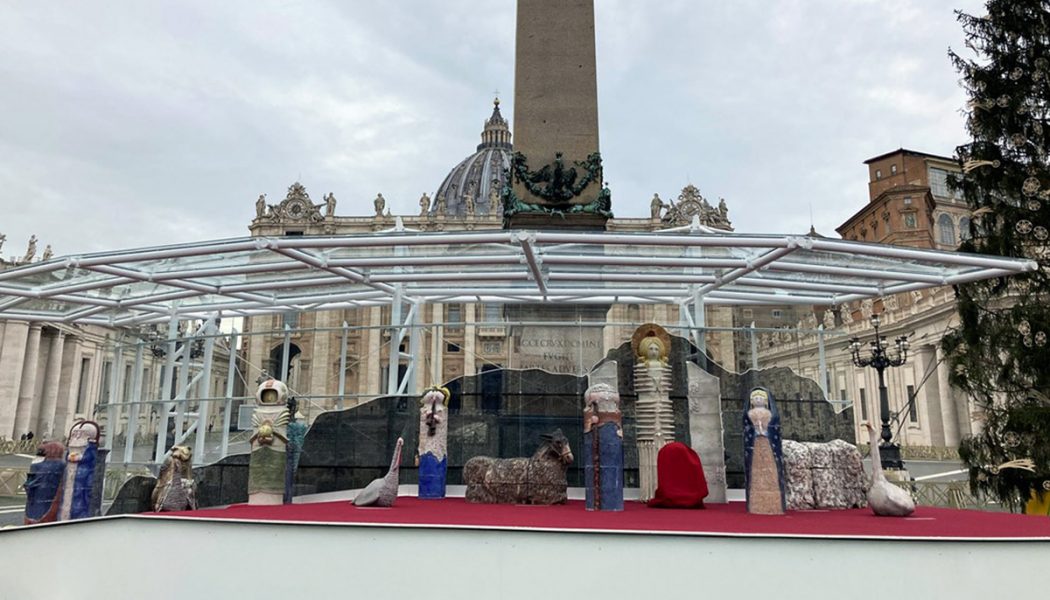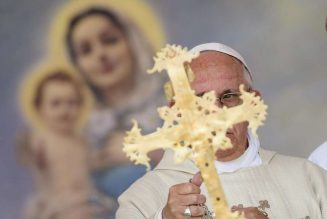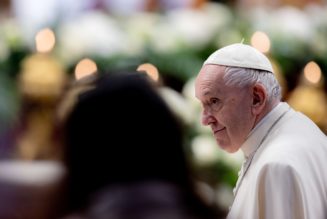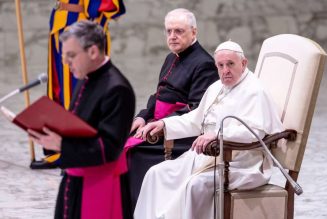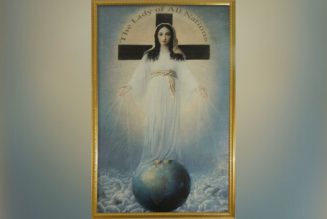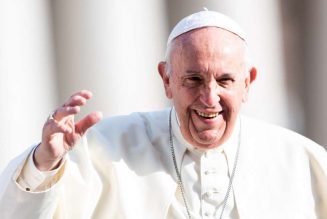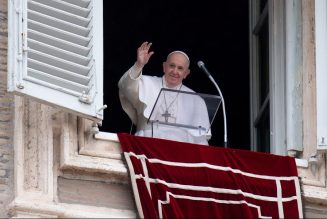VATICAN CITY — This year’s Vatican Nativity scene has drawn fierce criticism for its post-modern artistic look, which critics say radically breaks with traditional Nativity scenes and fails to evangelize or inspire others about the mystery of the Incarnation.
The Christmas presepio in St. Peter’s Square contains 20 modernistic ceramic objects, including the main figures in the story of the Nativity but with toy-like faces alongside the presence of an astronaut and a morbid, satanic-looking executioner — but no manger.
The figures, which include Our Lady depicted with blonde, curly hair, are spaced out on a minimalist stage with no landscape, cave, trees or streams that characterize usual Nativity scenes.
Reaction on social media and elsewhere has mostly ranged from “hideous,” “abhorrent” and a “disgrace,” to “demonic,” an “embarrassment” and a “mockery” of Christ’s birth. Tim Stanley, a well-known columnist for the UK’s Daily Telegraph, called it “absolutely terrifying,” while Vatican News’ Facebook page was filled with criticism even before it had been unveiled.
Just a few appeared to like it, with one on Facebook calling the scene “gorgeous” and a Twitter user saying it was “by far the Church’s best effort to bring me back into the fold.” (Another said he was considering becoming Catholic but said he’d remain Protestant after seeing it.)
Not since Pope St. John Paul II began the tradition in 1982 has the Vatican’s Nativity scene drawn such ire or departed so far from the conventional image of a manger and larger-than-life sized figures of Mary, Joseph, the shepherds, the Magi and accompanying animals.
The 2017 Nativity scene was previously the most controversial, causing an outcry after it featured a semi-naked man (which some viewed as homoerotic), a corpse and no sheep or oxen in front of what appeared to be a bombed-out church. The scene, called a “Nativity of Mercy,” came from an Italian abbey that turned out to be a favorite pilgrimage destination of LGBT activists.
Origin of the Figures
This year, the Vatican has called the Nativity scene “contemporary and unconventional,” but it actually contains figures that were originally made from 1965 to 1975 in the town of Castelli, in the Teramo diocese of Abruzzo in central Italy — a region hit by earthquakes in 2006 and 2016.
Famous for its ceramics, the idea for this presepio was conceived by Stefano Mattucci, the then-director of the town’s F.A. Grue Institute of Art, and designed by two artistic professors, Gianfranco Trucchia and Roberto Bentini. The scene was first exhibited in December 1965, then displayed at Trajan’s Market in Rome in 1970, and a few years later in Jerusalem, Bethlehem and Tel Aviv. Various figures were added, including a Muslim and a Jewish rabbi, increasing the total number to 54.
Fausto Cheng, one of the students at that time who helped create the figures, said in a 2018 interview that “revolutionary aspects” characterized its creation, “from breaking the classic patterns of ceramic art, the use of color, the representation of the Nativity in an original way.” He added that the scene had been “infused with contemporary events from recent years” that included “setting foot on the moon, the Second Vatican Council and the abolition of the death penalty” (the latter two themes reflecting matters being close to Pope Francis’ heart).
The decision to bring the figures to the Vatican two years later was the fruit of meetings between Bishop Lorenzo Leuzzi of Teramo and a group of artists and technicians, according to Marcello Mancini, vice president of the F.A. Grue Institute. They wished to bring some of the figures not only “related to Christianity” but also “related to some themes that are dear to our Pope,” he said. These included themes not only connected with science but also the environment with the inclusion of many animals. It is a “naturalistic crib,” he told local television, containing a “goat, sheep, a swan,” all of which are “objects that have an elegance and an incomparable stylistic interpretation.”
Striking a Nerve
But this year’s effort, coming in a year of trial for many families and individuals due to the COVID-19 crisis, appears to have struck a particular nerve. “It’s so divisive, I don’t hear a lot of people defending it,” said Rome-based art historian Elizabeth Lev who teaches at Duquesne University. People look to the Vatican in particular “for the tradition of beauty,” she added. “We keep beautiful things in there so that no matter how awful your life is, you can walk into St. Peter’s and that’s yours, that’s part of who you are, and it reflects who you are and the glory of who you are.”
“I don’t understand why we’d turn our back on that,” Lev added. “It seems to be part of this strange, modern loathing and rejection of our traditions.”
In its description of the Nativity scene, the Vatican said it was influenced by ancient Greek, Egyptian and Sumerian sculpture — something art historian Andrea Cionci, writing in the Italian daily Libero Quotidiano, traces back to the “liberal historical-critical method of interpreting Scripture” that “took over after the Second Vatican Council.” That approach, he said, has a “tendency to demystify everything that is supernatural in the Catholic faith.” Dogmas, miracles and divine interventions, he explained, are “assimilated into the residues of pre-existing pagan cults.”
Ottavio Bucarelli, pro-director of the cultural heritage department at the Pontifical Gregorian University in Rome, nevertheless sees the Nativity scene as “entirely legitimate” as it originates from an artistic institute that studies not only “ancient techniques” but also “innovative proposals in the artistic field, new ways to be experimented which today, in our eyes, can be perceived as a break with well-established tradition of the representation of the Nativity.”
He told ACI Stampa Dec. 14 that it is “therefore necessary to bring back our reflection to that historical-artistic reality” and look upon the figures “with those eyes,” and stressed the need to contextualize the “historical period and the environment in which it was created” — namely the ’60s and ’70s which were decades of “political, cultural and religious ferment.”
‘Innovation for Innovation’s Sake’
Lev agreed that the desire to bring such a Nativity scene to the Vatican is primarily a “question of innovation,” even though she believed the last thing people want in such a year of hardship and separation of families is “experimenting with the image of the Holy Family.” One possibility, she said, is that it could serve to “shock us into longing for a traditional Nativity” just as some argued that denying the sacraments this year due to the lockdown makes people long for them.
But Lev recalled that when St. Francis of Assisi began the tradition of Nativity scenes, he asked for the pope’s permission precisely because he did not want such a custom to be “misunderstood as innovation, just for the sake of innovation” but rather to “invoke the mystery of the Incarnation.” St. Bonaventure, she added, later made the point in the 1220s when people were wealthy and had all they needed, that he wished to “reawaken the sluggish faith in the heart of Christians.”
“I would propose to you that I haven’t seen anyone say they feel more Christian because they’ve seen it [this year’s Vatican Nativity scene],” Lev said. “I’ve seen people laugh at it, people have been throwing the word demonic around way, way too much, but it’s not awakening a sluggish faith. If anything it’s burying a sluggish, half-dead faith under a heap of mockery – and it really looks like innovation for innovation’s sake.”
The Register asked the Holy See Press Office if it might replace the Nativity scene in view of the widespread criticism, but has yet to receive a reply.
Lev doesn’t think it should be removed, but said that some regret and admission that it was an “ill-considered choice” would be welcome given the “division and hurt it has caused,” but she is not optimistic that will happen.





Join Our Telegram Group : Salvation & Prosperity
